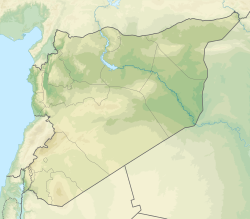
Back ሐማት Amharic حماة Arabic ܚܡܬ (ܡܕܝܢܬܐ) ARC حماه ARZ Həma Azerbaijani حماه AZB Хама Byelorussian Хама Bulgarian হামা Bengali/Bangla Hama Breton
Hama
حَمَاة | |
|---|---|
| Nicknames: | |
| Coordinates: 35°8′6″N 36°45′0″E / 35.13500°N 36.75000°E | |
| Country | |
| Governorate | Hama Governorate |
| District | Hama District |
| Subdistrict | Hama Subdistrict |
| Control | Syrian transitional government |
| First settled | 1500BC~ |
| Elevation | 305 m (1,001 ft) |
| Population (2023 census) | |
• Total | 996,000[1] |
| • Ethnicities | Syrians |
| • Religions | Sunni Islam Syriac Orthodox Church Greek Orthodox Church |
| Demonym(s) | Arabic: حموي, romanized: Ḥamwi |
| Time zone | UTC+2 (EET) |
| • Summer (DST) | UTC+3 (EEST) |
| Area code(s) | Country code: +963 City code: 33 |
| Geocode | C2987 |
| Climate | BSk |
| Website | www |
 | |
Hama (Arabic: حَمَاة Ḥamāh, [ħaˈmaː]; Syriac: ܚܡܳܬ, romanized: ħ(ə)mɑθ, lit. 'fortress'; Biblical Hebrew: חֲמָת, romanized: Ḥămāṯ) is a city on the banks of the Orontes River in west-central Syria. It is located 213 kilometres (132 mi) north of Damascus and 46 km (29 mi) north of Homs. It is the provincial capital of the Hama Governorate. With a population of 996,000 (2023 census), Hama is one of the four largest cities in Syria, with Damascus, Aleppo and Homs, it is also home to the dessert of Halawet el Jibn.[2][3]
The city is renowned for its seventeen norias used for watering the gardens, which are claimed to date back to 1100 BC. Though historically used for irrigation, the norias today are purely for show for the local population.
- ^ "2023 official census". cbss. Retrieved 3 January 2024.
- ^ Updated: Your Cheat Sheet to the Syrian Conflict Archived 3 November 2022 at the Wayback Machine. PBS.
- ^ "Hamah (Syria)". Encyclopædia Britannica. Archived from the original on 16 June 2013. Retrieved 3 June 2013.
© MMXXIII Rich X Search. We shall prevail. All rights reserved. Rich X Search










